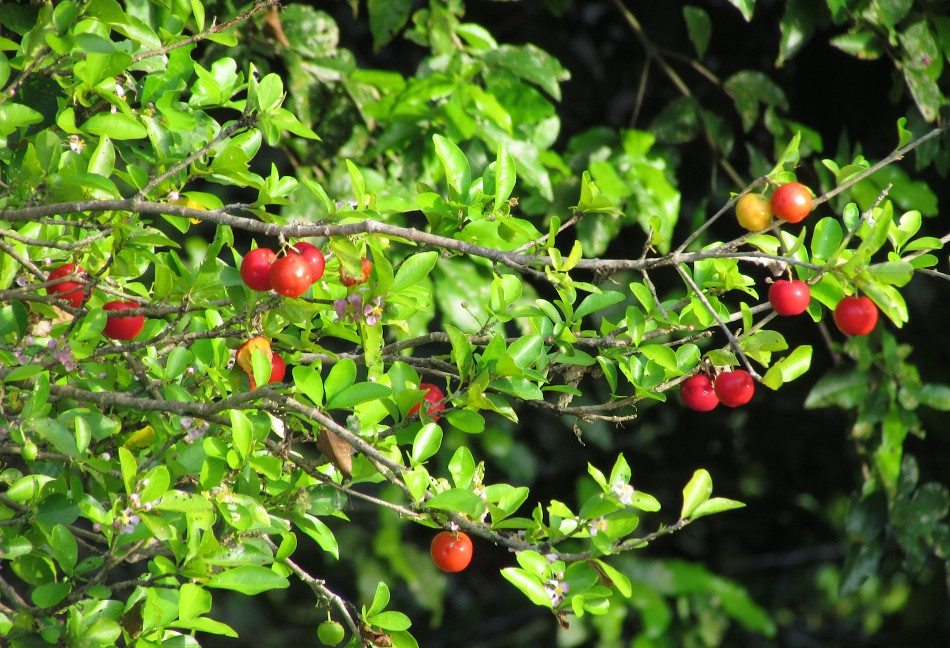Malpighia emarginata DC. - syn. Malpighia glabra hort., pro parte; Malpighia punicifolia auct. - Malpighiaceae
acerola, Barbados cherry, West Indian cherry, Acerola-Kirsche, Barbadoskirsche
Evergreen shrub or tree, 3-8m high, native from Mexico to Ecuador, exact native range in neotropics obscure, widely cultivated for fruit; leaves opposite, almost sessile, entire; flowers solitare or in umbels up to 4, petals white, pink, or red; fruit a drupe, red or scarlet, depressed-ovoid, 1-3 cm in diameter, acid. https://npgsweb.ars-grin.gov/gringlobal/taxonomydetail.aspx?id=404858
„Acerola is indigenous to the Lesser Antilles from St. Croix to Trinidad, also Curacao and Margarita and neighbouring Central America including Mexico and southern Texas and northern South America as far south as Bahia in Brazil. It has become naturalized in Cuba, Jamaica and Puerto Rico after cultivation, and is commonly grown in house yards in the Bahamas and Bermuda, and to a lesser extent in Central and South America. It is now cultivated globally in the tropics and subtropics… Fruit is a drupe, oblate to round, shallowly 3-lobed with a thin epicarp which turns from green to pale greenish yellow to pink and glossy red when ripe.“ [Lim, T. K. „Malpighia emarginata.“ Edible Medicinal And Non Medicinal Plants: Volume 3, Fruits. Dordrecht: Springer Netherlands, 2011. 153-159]
„The Acerola, or West Indian cherry, which belongs to the Malpighiaceae family, is native to the West Indies and tropical South America. Fully ripe fruits have the highest vitamin C content of all fruits, ranging from 1,000 to 2,000mg 100 g−1. Processing the fruit into juice results in little loss of vitamin C; consequently, the juice is used to improve the ascorbic acid content of other fruit juices. Fruits are ready for harvesting when they turn pink or red. They should not be allowed to ripen fully on the trees because they deteriorate rapidly. The fruits are highly perishable after harvest.“
[M. Mohammed, 2 - Acerola (Malpighia emarginata DC.), Editor(s): Elhadi M. Yahia, In Woodhead Publishing Series in Food Science, Technology and Nutrition, Postharvest Biology and Technology of Tropical and Subtropical Fruits, Woodhead Publishing, 2011, 27-48]
„M.mexicana A.Juse is grown in Mexico for its fruits… M.glabra L. (syn M. punicifolia L.). which has small insipid fruits, and grows from southern USA to South America, may be known by the name semeruco in Venezuela. Both latin names are sometimes incorrectly used as synonyms for M.emarginata, but M.emarginata and M.glabra have very different gynoecia…“
[Genetic resources of tropical and sub- tropical fruits and nuts (excluding Musa), IBPGR, Rome 1986, 52-54]
Ascorbic acid content reached e.g. 1921mg/100g, determined in the acerola crude concentrated extract. Polyphenols were also very high with 3300mgGAE/100g.
[De Rosso, Veridiana V., and Adriana Z. Mercadante. „The high ascorbic acid content is the main cause of the low stability of anthocyanin extracts from acerola.“ Food Chemistry 103.3 (2007): 935-943]
 furfural (R=H) and 5-methylfurfural (R=Me)
furfural (R=H) and 5-methylfurfural (R=Me)
Main volatile components isolated from acerola fruit by simultaneous steam distillation-solvent extraction were furfural, hexadecanoic acid, 3-methyl-3-butenol, and limonene. „The amounts of esters, 3-methyl-3-butenol, and their various esters were thought to contribute to the unique flavor of the acerola fruit.“
[Pino, Jorge A., and Rolando Marbot. „Volatile flavor constituents of acerola (Malpighia emarginata DC.) fruit.“ Journal of agricultural and food chemistry 49.12 (2001): 5880-5882]
„The fruit is small and red-colored at mature stage, quite similar to a cherry, and its pulp is very juicy, cooling and possesses a fruity and sweet flavor… Despite being very appreciated for its flavor and color, it is also nutritionally important due to its high vitamin C content (1000-4500 mg of vitamin C per 100 g of fruit… In another paper, authors identified free and glycosidically-bound flavor compounds of acerola fruit by GC and GC/MS. It was observed that among 46 compounds identified in the volatile fraction the majority were alcohols, such as 3-methyl-but-2-en-1-ol, 3-methyl-butan-1-ol and 2-methyl-butan-1-ol. There were also 42 aglycones identified for the first time in this fruit and they observed that alcohols and norisoprenoids were predominant. According to the authors, the hydrolysis of these aglycones could increase the fruity aroma of acerola.“
[Bicas, Juliano Lemos, et al. „Volatile constituents of exotic fruits from Brazil.“ Food Research International 44.7 (2011): 1843-1855] PDF

Fruiting branches of M.emarginata in Venezuela Useful Tropical Plants Photograph by: Wilfredo R. Rodríguez H. CC BY-SA 3.0
